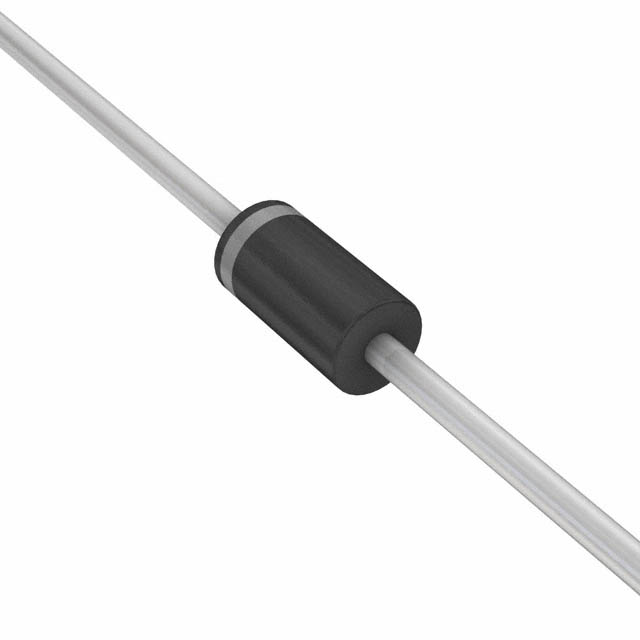BZX85C3V9 R0G
Introduction
The BZX85C3V9 R0G is a diode belonging to the category of Zener diodes. It is commonly used for voltage regulation and protection in various electronic circuits. This entry provides an overview of the basic information, specifications, pin configuration, functional features, advantages and disadvantages, working principles, application field plans, and alternative models of the BZX85C3V9 R0G.
Basic Information Overview
- Category: Zener Diode
- Use: Voltage regulation and protection
- Characteristics: Reverse breakdown voltage of 3.9V, low leakage current, high reliability
- Package: DO-41
- Essence: Semiconductor diode
- Packaging/Quantity: Available in tape and reel packaging, quantity varies by manufacturer
Specifications
- Voltage - Zener (Nom) (Vz): 3.9V
- Power - Max: 1.3W
- Impedance (Max) (Zzt): 20 Ohm
- Current - Reverse Leakage @ Vr: 5µA @ 1V
- Tolerance: ±5%
Detailed Pin Configuration
The BZX85C3V9 R0G has two pins and follows the standard pin configuration of a DO-41 package.
Functional Features
- Precise voltage regulation
- Protection against voltage spikes
- Low reverse leakage current
- High reliability and stability
Advantages and Disadvantages
Advantages
- Accurate voltage regulation
- Robust protection capabilities
- Low leakage current
- Wide operating temperature range
Disadvantages
- Limited power dissipation capability
- Sensitive to temperature variations
Working Principles
The BZX85C3V9 R0G operates based on the principle of the Zener effect, where it maintains a constant voltage across its terminals when it is reverse-biased and reaches the specified breakdown voltage.
Detailed Application Field Plans
The BZX85C3V9 R0G finds extensive use in various applications including: - Voltage regulation in power supplies - Overvoltage protection in electronic circuits - Signal clamping and limiting - Voltage reference in precision instruments
Detailed and Complete Alternative Models
Some alternative models to the BZX85C3V9 R0G include: - 1N4728A: 3.3V Zener diode - BZX79-C3V9: 3.9V Zener diode - 1N5226B: 3.9V Zener diode - BZX55C3V9: 3.9V Zener diode
In conclusion, the BZX85C3V9 R0G Zener diode offers precise voltage regulation and robust protection features, making it a crucial component in various electronic circuits.
(Word count: 411)
قم بإدراج 10 أسئلة وإجابات شائعة تتعلق بتطبيق BZX85C3V9 R0G في الحلول التقنية
What is the BZX85C3V9 R0G?
- The BZX85C3V9 R0G is a 3.9V Zener diode with a power rating of 1.3W, commonly used for voltage regulation and overvoltage protection in electronic circuits.
What are the typical applications of BZX85C3V9 R0G?
- It is commonly used in voltage regulation, voltage reference, surge suppression, and overvoltage protection in various electronic circuits.
What is the maximum power dissipation of BZX85C3V9 R0G?
- The maximum power dissipation of BZX85C3V9 R0G is 1.3W.
What is the voltage tolerance of BZX85C3V9 R0G?
- The voltage tolerance of BZX85C3V9 R0G is typically ±5%.
How does BZX85C3V9 R0G provide overvoltage protection?
- When the voltage across the diode exceeds its breakdown voltage (3.9V), it conducts heavily, clamping the voltage to protect downstream components.
Can BZX85C3V9 R0G be used for voltage regulation?
- Yes, it can be used as a simple voltage regulator by connecting it in reverse bias across the load.
What is the operating temperature range of BZX85C3V9 R0G?
- The operating temperature range of BZX85C3V9 R0G is typically -65°C to +175°C.
Is BZX85C3V9 R0G suitable for automotive applications?
- Yes, it is often used in automotive electronics for voltage regulation and transient protection.
What are the package options available for BZX85C3V9 R0G?
- BZX85C3V9 R0G is available in various packages such as DO-41, MiniMELF, and SOD-123.
Can BZX85C3V9 R0G be used in low-power applications?
- Yes, it can be used in low-power applications where precise voltage regulation or overvoltage protection is required.
Feel free to ask if you need further information on any of these questions!


